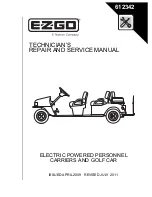
ELECTRICAL COMPONENTS: GASOLINE
VEHICLES
Battery
13
DANGER
– External: Flush with water. Call a physician immediately.
– Internal: Drink large quantities of milk or water. Follow with milk of magnesia or vegetable
oil. Call a physician immediately.
– Eyes: Flush with water for 15 minutes. Call a physician immediately.
GENERAL INFORMATION
See preceding DANGER statement.
Gasoline vehicles are equipped with 12-volt, low-maintenance batteries. When changing a 12-volt battery in any
gasoline-powered vehicle, the same size battery with adequate amperage ratings should be used as a replacement.
The manufacturer recommends a group 70, side-post battery (CC P/N 103496801), with a 650 cranking amp rating at
32 °F (0 °C), 500 CCA at 0 °F (-17.8 °C) and a reserve capacity of at least 105 minutes. The group 70 classification
indicates battery size: 8-1/4 inches W x 6-1/2 inches D x 7-1/4 inches H (21.0 cm W x 16.5 cm D x 18.4 cm H). It is
important to use the proper size to ensure that the battery clamp will fit correctly.
TESTING THE BATTERY
See Test Procedure 1 – Battery on page 11-8.
PREVENTIVE MAINTENANCE
1.
To keep the battery in good operating condition, remove corrosion immediately. Post connections should be
clean and tight. Frayed or worn wires should be replaced. After all cables have been connected and properly
tightened to 80 in-lb (9 N·m), coat terminals with Battery Terminal Protector Spray (CC P/N 1014305) to prevent
future corrosion.
2.
The battery should be kept clean and dry to prevent self-discharge. Dirt, grime, and acid spillage should be
removed. Wash the battery with a bristle brush and a solution of water and bicarbonate of soda (1 cup (237 mL)
baking soda – per 1 gallon (3.8 L) of water). Rinse with water. Do not allow any solution to enter the battery
through the vent cap holes.
See Self-Discharge on page 13-19.
3.
Maintain the proper water level.
See Water Level on page 13-20.
4.
Check the battery periodically to ensure that it is in a full state of charge.
See Charging the Battery on page
5.
Keep the battery hold-down clamp tight.
See Vibration Damage on page 13-20.
SELF-DISCHARGE
Dirt and battery acid can provide a path for a small current draw that slowly discharges the battery. To prevent
self-discharge, the battery should always be kept clean.
Hot weather also has an effect on a battery’s self-discharge rate. The higher the temperature, the quicker a battery will
discharge. Therefore, the battery should be checked more often in hotter climates. When storing the battery, keep it in
a cool place.
See Battery Storage on page 13-21.
2013 Carryall 295/XRT 1550 Maintenance and Service Manual
Page 13-19
Summary of Contents for Carryall XRT 1550
Page 2: ......
Page 28: ......
Page 40: ......
Page 62: ......
Page 106: ......
Page 120: ......
Page 180: ......
Page 224: ......
Page 272: ......
Page 310: ......
Page 344: ......
Page 362: ......
Page 370: ......
Page 418: ...NOTES...
Page 428: ...NOTES...
Page 430: ...NOTES...
Page 431: ......
Page 432: ......































